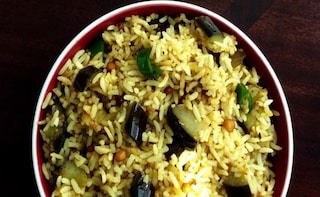Image Credits: Instagram/veggibites
2 Tbsp black gram (urad dal)
3 Tbsp coriander seeds
5-6 Tbsp red chillies (Bedige or Kashmiri)
1 cinnamon stick
1 cardamom
3 cloves
½ tsp poppy seeds
1 nutmeg flower (javithri)
¼ tsp peppercorns
¼ tsp cumin seeds
¼ tsp fenugreek seeds
2 Tbsp copra (dried coconut or you can substitute with fresh coconut)
Salt to taste
½ tsp turmeric powderMethod:1. Roast (without oil) channa dal, then add urad dal, coriander seeds, poppy seeds and red chillies, adding one ingredient at a time 2. Add all the other spices to this mix and continue to roast.3. Add the dried coconut to this mix, then add salt and turmeric powder and blend in a mixer after roasting for a while.
(Serves 4)Ingredients:¼ kg green brinjal, chopped
2 Tbsp cooking oil
4 Tbsp Vangi Bath powder
1-2 Tbsp ghee
½ tsp mustard seeds
1 ½ tsp Bengal gram (channa dal)
1 ½ tsp black gram (urad dal)
2 sprigs curry leaves
A pinch of asafoetida
½ tsp sugar
½ tsp turmeric
Salt: to taste
A small ball of tamarind
½ cup peanuts and/or cashew nuts
3 cups rice (cooked)
A few sprigs corianderMethod:1. Temper the mustard, channa dal and urad dal (use only ½ teaspoon of these two dals if you are making the Vangi Bath masala yourself). Also add the curry leaves and asafoetida.2. Add the rest of the oil and shallow fry the brinjal.3. Add the turmeric, salt and sugar to the brinjal.4. Add the tamarind extract (from the small ball of tamarind – you can use warm water for this).5. Add the masala and toss brinjals delicately in the pan. You can add a small quantity of green peas (optional).6. Close the dish with a lid for a few minutes after the brinjal is cooked.7. Cool down the cooked rice (ensure the rice is not hot or soggy) and mix the ghee with the rice. Then add the entire vangi mix and stir slowly.8. Shallow fry the nuts and add it along with freshly chopped coriander as a garnish.About the Author:Ashwin Rajagopalan is a cross cultural training expert and lifestyle writer. When he's not writing about food, he thinks about gadgets, trends and travel experiences. He enjoys communicating across cultures and borders in his weekday work avatar as a content and editorial consultant for a global major and one of India's only cross cultural trainers.Disclaimer:The opinions expressed within this article are the personal opinions of the author. NDTV is not responsible for the accuracy, completeness, suitability, or validity of any information on this article. All information is provided on an as-is basis. The information, facts or opinions appearing in the article do not reflect the views of NDTV and NDTV does not assume any responsibility or liability for the same.
Advertisement
Advertisement
2 Tbsp black gram (urad dal)
3 Tbsp coriander seeds
5-6 Tbsp red chillies (Bedige or Kashmiri)
1 cinnamon stick
1 cardamom
3 cloves
½ tsp poppy seeds
1 nutmeg flower (javithri)
¼ tsp peppercorns
¼ tsp cumin seeds
¼ tsp fenugreek seeds
2 Tbsp copra (dried coconut or you can substitute with fresh coconut)
Salt to taste
½ tsp turmeric powderMethod:
Advertisement
Advertisement
(Serves 4)Ingredients:¼ kg green brinjal, chopped
2 Tbsp cooking oil
4 Tbsp Vangi Bath powder
1-2 Tbsp ghee
½ tsp mustard seeds
1 ½ tsp Bengal gram (channa dal)
1 ½ tsp black gram (urad dal)
2 sprigs curry leaves
A pinch of asafoetida
½ tsp sugar
½ tsp turmeric
Salt: to taste
A small ball of tamarind
½ cup peanuts and/or cashew nuts
3 cups rice (cooked)
A few sprigs corianderMethod:1. Temper the mustard, channa dal and urad dal (use only ½ teaspoon of these two dals if you are making the Vangi Bath masala yourself). Also add the curry leaves and asafoetida.2. Add the rest of the oil and shallow fry the brinjal.3. Add the turmeric, salt and sugar to the brinjal.4. Add the tamarind extract (from the small ball of tamarind – you can use warm water for this).5. Add the masala and toss brinjals delicately in the pan. You can add a small quantity of green peas (optional).6. Close the dish with a lid for a few minutes after the brinjal is cooked.7. Cool down the cooked rice (ensure the rice is not hot or soggy) and mix the ghee with the rice. Then add the entire vangi mix and stir slowly.8. Shallow fry the nuts and add it along with freshly chopped coriander as a garnish.About the Author:Ashwin Rajagopalan is a cross cultural training expert and lifestyle writer. When he's not writing about food, he thinks about gadgets, trends and travel experiences. He enjoys communicating across cultures and borders in his weekday work avatar as a content and editorial consultant for a global major and one of India's only cross cultural trainers.Disclaimer:The opinions expressed within this article are the personal opinions of the author. NDTV is not responsible for the accuracy, completeness, suitability, or validity of any information on this article. All information is provided on an as-is basis. The information, facts or opinions appearing in the article do not reflect the views of NDTV and NDTV does not assume any responsibility or liability for the same.
For the latest food news, health tips and recipes, like us on Facebook or follow us on Twitter and YouTube.
Advertisement
